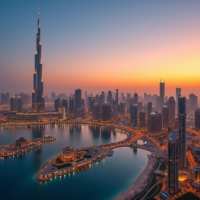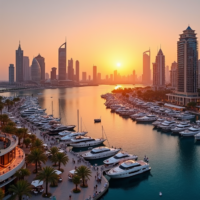The pursuit of highly efficient urban planning often leads experts to explore a variety of models and concepts, one of which is the implementation of ‘clusters’ within the cityscape. Clusters, which group similar industries or residential areas together, are considered pivotal for fostering economic growth, enhancing community cohesion, and reducing environmental impacts. This article dives into the multifaceted impact of clusters in urban environments, looking at how they not only improve city function but also provide livability and sustainability.
Industrial Clusters: Powerhouses of Economic Synergy
Industrial clusters are at the heart of modern economic development, often found in areas that specialize in a specific sector like technology, manufacturing, or creative arts. These clusters are designed to boost productivity by concentrating resources, talent, and ideas in one geographical area. The benefits include:
- Increased innovation due to close proximity of businesses and talent.
- Enhanced collaboration between companies and research institutions.
But these industrial zones aren’t solely focused on economic gains; they also offer social value by generating employment and fostering skilled communities. For example, Silicon Valley in the United States not only stands as a tech mecca but also provides a dense network of opportunities and career pathways for locals and immigrants alike. Another country with a notable cluster is Germany, where the city of Wolfsburg is synonymous with the automotive industry, anchoring an entire region’s economy and identity.

Residential Clusters: Crafting Connected Communities
On the residential front, clusters are also considered essential to creating vibrant, supportive neighborhoods. By concentrating housing in specific areas, cities can focus their services and amenities more effectively, thus enhancing the quality of life for residents. Benefits include:
- Improved social ties through community-focused urban design.
- Concentrated amenities like parks, schools, and medical facilities.
Cities that have embraced residential clustering often feature a patchwork of neighborhoods, each with its own unique character and sense of place. Take for instance Copenhagen, Denmark, which not only boasts a high quality of living but also features a tapestry of well-defined residential areas, each infused with local culture and communal spaces.
Challenges and Opportunities in Cluster-Based Urban Planning
While the creation of both industrial and residential clusters presents numerous advantages, urban planners face a myriad of challenges when shaping these distinct zones within a city. Here’s a look at some of the primary obstacles and opportunities:
- Balancing Economic and Residential Needs: Urban areas must ensure that clusters cater to larger numbers of people without sacrificing the needs of residents or businesses.
- Infrastructure and Transportation: Efficiently connecting these clusters with reliable infrastructure is critical to their success and accessibility.
- Environmental Considerations: Maintaining eco-friendly practices while developing industrial or residential clusters is vital for sustainable urban growth.
In the pursuit of ideal urban clusters, some great places that have successfully incorporated mixed-use clusters are also providing valuable blueprints. These areas combine residential and commercial spaces, sometimes with a sprinkling of industrial facilities, offering a glimpse into a more integrated approach.
The Evolution of Urban Clusters: A Historical Perspective
The concept of clustering has roots that run deep into the history of urban development. Early examples took place as far back as the Industrial Revolution, where burgeoning factories spawned adjacent residential clusters. This table highlights a few key historical moments that shaped the concept of urban clusters:
| Era | Development | Impact on Clustering |
|---|---|---|
| Industrial Revolution | Emergence of factory towns | Formation of industrial and adjacent residential clusters |
| Post-War Period | Suburban expansion | Spatial separation; rise of residential clusters |
| Late 20th Century | Tech boom and gentrification | Development of modern industrial clusters |
| 21st Century | Smart urban planning | Integrated, mixed-use cluster development |
While looking at the past provides context, the future of urban clusters is only one part of larger conversations about sustainable and adaptive cities. As the global population swells and the need for efficient living spaces becomes more pressing, the role of clusters is not only expected to grow but to evolve, offering snapshots of the urban tapestry we aspire to weave.

Clusters and Sustainability: Creating a Greener Urban Future
Embracing clusters within urban environments also features prominently in driving sustainability. Industrial clusters, while strengthening economic might, have the potential to minimize environmental impacts through shared resources, including energy and waste management systems. Moreover, clustering can lead to innovation in green technology, aided by a concentrated talent pool and financial resources. Residential clusters contribute to sustainability by reducing the reliance on vehicles, thanks to the proximity of essential services and amenities. Green spaces within these residential clusters are also pivotal for enhancing biodiversity and providing residents with areas for recreation and relaxation, which contributes to overall well-being.
Leveraging Technology in Cluster Development
In recent years, technology has played a critical role in optimizing cluster-based urban planning. Smart city initiatives across the globe harness data and connectivity to ensure clusters are not only efficient but also responsive to the needs of their populations. Technology is instrumental in:
- Enhancing transportation systems within and between clusters.
- Monitoring environmental impact and resource usage for better sustainability.
Policy and Planning: The Role of Governance
Effective governance is crucial in translating cluster-based urban planning from theory into reality. Policymakers and planners must work hand-in-hand to ensure that clusters serve the economic and social interests of the city while preserving its cultural heritage. Key strategies include:
- Zoning regulations that support the development of industrial and residential clusters.
- Incentive programs to attract businesses and residents to newly developed clusters.
The Future of Clusters: Trends and Innovations
As we move further into the 21st century, urban clusters are set to become even more complex and interconnected. Innovations in transportation, like autonomous vehicles and advanced public transit systems, will make travel between clusters more seamless. Meanwhile, the rise of remote work might influence the design and necessity of certain types of industrial clusters, allowing for more flexibility in residential clustering.

Understanding the Global Impact of Clusters
One cannot discuss the success and challenges of urban clusters without appreciating their global implications. Industrial clusters, by driving economic specialization, have implications for international trade and cooperation. Residential clusters, on the other hand, influence migration patterns and housing policies internationally. Thus, what happens in one country’s clusters can have ripple effects across borders, reinforcing the need for a coordinated, global approach to urban planning.
FAQ
Q1: What exactly is an urban cluster?
A1: An urban cluster refers to a concentrated area within a city that is designed to serve a specific function, such as industrial activity or residential living. These clusters are strategically developed to enhance efficiency, connectivity, and community cohesion by grouping together similar activities and structures.
Q2: How do clusters contribute to a city’s sustainability?
A2: Clusters enhance a city’s sustainability by reducing the need for long-distance travel and transportation, encouraging the sharing of resources among businesses or amenities within a residential area, and promoting innovations in energy efficiency and resource management. They also can contribute to the creation of green spaces and the reduction of urban sprawl.
Q3: Can clusters really improve a community’s quality of life?
A3: Yes, clusters can significantly improve a community’s quality of life by ensuring essential services and amenities are within easy reach, fostering stronger social networks, and offering economic opportunities. Having a well-designed cluster can lead to a more engaged and content urban population.
Q4: What challenges do planners face when implementing clusters in urban areas?
A4: Planners face challenges such as balancing the needs of residents and businesses, integrating sufficient infrastructure and transportation networks, and adhering to environmental sustainability practices. Additionally, they have to consider the long-term growth and adaptability of the clusters within the ever-evolving urban landscape.
Q5: Are there any downsides to urban clustering?
A5: While clustering has many benefits, there can be downsides if not planned carefully. These can include the risk of overconcentration, which may lead to traffic congestion, increased pollution, and the potential for economic downturns if a clustered industry struggles. It’s essential for urban planners to take a holistic and flexible approach to avoid these pitfalls.









